JEEP PATRIOT 2020 Owner handbook (in English)
Manufacturer: JEEP, Model Year: 2020, Model line: PATRIOT, Model: JEEP PATRIOT 2020Pages: 332, PDF Size: 1.99 MB
Page 261 of 332
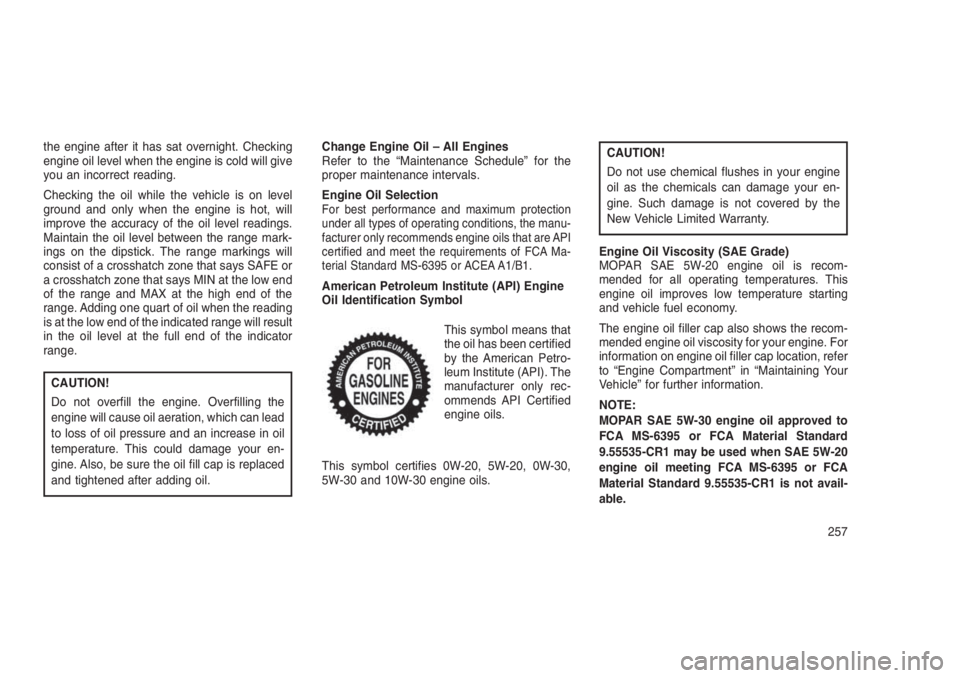
the engine after it has sat overnight. Checking
engine oil level when the engine is cold will give
you an incorrect reading.
Checking the oil while the vehicle is on level
ground and only when the engine is hot, will
improve the accuracy of the oil level readings.
Maintain the oil level between the range mark-
ings on the dipstick. The range markings will
consist of a crosshatch zone that says SAFE or
a crosshatch zone that says MIN at the low end
of the range and MAX at the high end of the
range. Adding one quart of oil when the reading
is at the low end of the indicated range will result
in the oil level at the full end of the indicator
range.
CAUTION!
Do not overfill the engine. Overfilling the
engine will cause oil aeration, which can lead
to loss of oil pressure and an increase in oil
temperature. This could damage your en-
gine. Also, be sure the oil fill cap is replaced
and tightened after adding oil.Change Engine Oil – All Engines
Refer to the “Maintenance Schedule” for the
proper maintenance intervals.
Engine Oil Selection
For best performance and maximum protection
under all types of operating conditions, the manu-
facturer only recommends engine oils that are API
certified and meet the requirements of FCA Ma-
terial Standard MS-6395 or ACEA A1/B1.
American Petroleum Institute (API) Engine
Oil Identification Symbol
This symbol means that
the oil has been certified
by the American Petro-
leum Institute (API). The
manufacturer only rec-
ommends API Certified
engine oils.
This symbol certifies 0W-20, 5W-20, 0W-30,
5W-30 and 10W-30 engine oils.
CAUTION!
Do not use chemical flushes in your engine
oil as the chemicals can damage your en-
gine. Such damage is not covered by the
New Vehicle Limited Warranty.
Engine Oil Viscosity (SAE Grade)
MOPAR SAE 5W-20 engine oil is recom-
mended for all operating temperatures. This
engine oil improves low temperature starting
and vehicle fuel economy.
The engine oil filler cap also shows the recom-
mended engine oil viscosity for your engine. For
information on engine oil filler cap location, refer
to “Engine Compartment” in “Maintaining Your
Vehicle” for further information.
NOTE:
MOPAR SAE 5W-30 engine oil approved to
FCA MS-6395 or FCA Material Standard
9.55535-CR1 may be used when SAE 5W-20
engine oil meeting FCA MS-6395 or FCA
Material Standard 9.55535-CR1 is not avail-
able.
257
Page 262 of 332
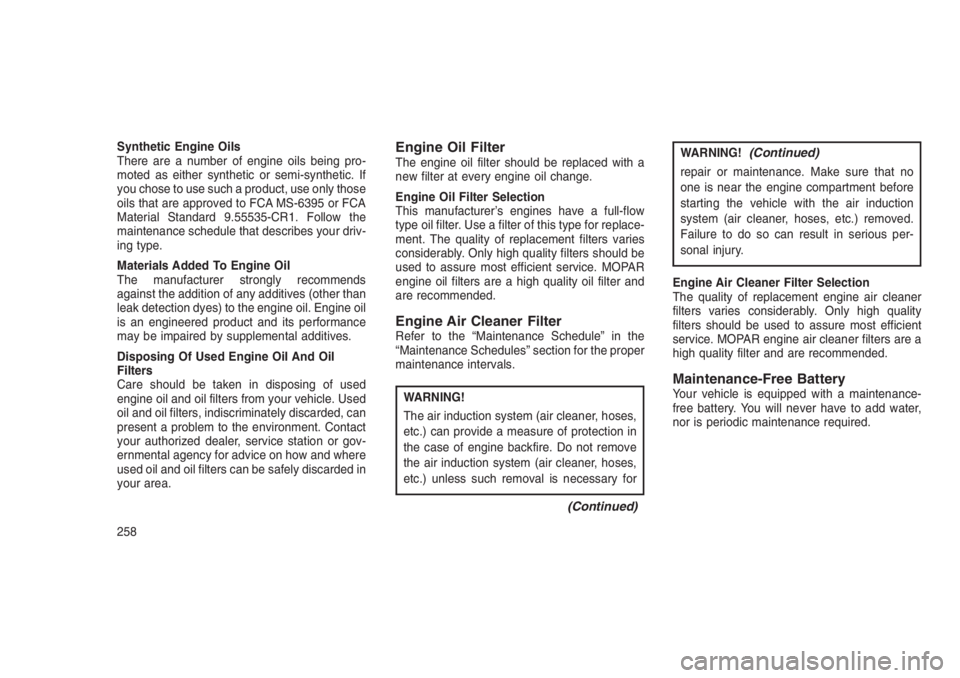
Synthetic Engine Oils
There are a number of engine oils being pro-
moted as either synthetic or semi-synthetic. If
you chose to use such a product, use only those
oils that are approved to FCA MS-6395 or FCA
Material Standard 9.55535-CR1. Follow the
maintenance schedule that describes your driv-
ing type.
Materials Added To Engine Oil
The manufacturer strongly recommends
against the addition of any additives (other than
leak detection dyes) to the engine oil. Engine oil
is an engineered product and its performance
may be impaired by supplemental additives.
Disposing Of Used Engine Oil And Oil
Filters
Care should be taken in disposing of used
engine oil and oil filters from your vehicle. Used
oil and oil filters, indiscriminately discarded, can
present a problem to the environment. Contact
your authorized dealer, service station or gov-
ernmental agency for advice on how and where
used oil and oil filters can be safely discarded in
your area.Engine Oil FilterThe engine oil filter should be replaced with a
new filter at every engine oil change.
Engine Oil Filter Selection
This manufacturer’s engines have a full-flow
type oil filter. Use a filter of this type for replace-
ment. The quality of replacement filters varies
considerably. Only high quality filters should be
used to assure most efficient service. MOPAR
engine oil filters are a high quality oil filter and
are recommended.
Engine Air Cleaner FilterRefer to the “Maintenance Schedule” in the
“Maintenance Schedules” section for the proper
maintenance intervals.
WARNING!
The air induction system (air cleaner, hoses,
etc.) can provide a measure of protection in
the case of engine backfire. Do not remove
the air induction system (air cleaner, hoses,
etc.) unless such removal is necessary for
(Continued)
WARNING!(Continued)
repair or maintenance. Make sure that no
one is near the engine compartment before
starting the vehicle with the air induction
system (air cleaner, hoses, etc.) removed.
Failure to do so can result in serious per-
sonal injury.
Engine Air Cleaner Filter Selection
The quality of replacement engine air cleaner
filters varies considerably. Only high quality
filters should be used to assure most efficient
service. MOPAR engine air cleaner filters are a
high quality filter and are recommended.
Maintenance-Free BatteryYour vehicle is equipped with a maintenance-
free battery. You will never have to add water,
nor is periodic maintenance required.
258
Page 263 of 332
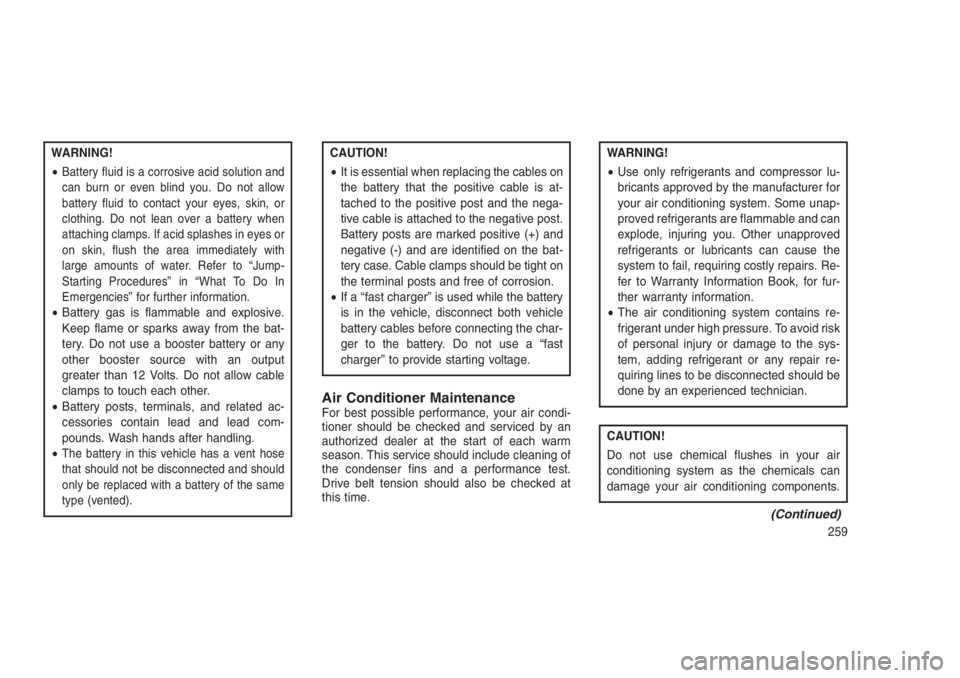
WARNING!
•
Battery fluid is a corrosive acid solution and
can burn or even blind you. Do not allow
battery fluid to contact your eyes, skin, or
clothing. Do not lean over a battery when
attaching clamps. If acid splashes in eyes or
on skin, flush the area immediately with
large amounts of water. Refer to “Jump-
Starting Procedures” in “What To Do In
Emergencies” for further information.
•Battery gas is flammable and explosive.
Keep flame or sparks away from the bat-
tery. Do not use a booster battery or any
other booster source with an output
greater than 12 Volts. Do not allow cable
clamps to touch each other.
•Battery posts, terminals, and related ac-
cessories contain lead and lead com-
pounds. Wash hands after handling.
•
The battery in this vehicle has a vent hose
that should not be disconnected and should
only be replaced with a battery of the same
type (vented).
CAUTION!
•It is essential when replacing the cables on
the battery that the positive cable is at-
tached to the positive post and the nega-
tive cable is attached to the negative post.
Battery posts are marked positive (+) and
negative (-) and are identified on the bat-
tery case. Cable clamps should be tight on
the terminal posts and free of corrosion.
•If a “fast charger” is used while the battery
is in the vehicle, disconnect both vehicle
battery cables before connecting the char-
ger to the battery. Do not use a “fast
charger” to provide starting voltage.
Air Conditioner MaintenanceFor best possible performance, your air condi-
tioner should be checked and serviced by an
authorized dealer at the start of each warm
season. This service should include cleaning of
the condenser fins and a performance test.
Drive belt tension should also be checked at
this time.
WARNING!
•Use only refrigerants and compressor lu-
bricants approved by the manufacturer for
your air conditioning system. Some unap-
proved refrigerants are flammable and can
explode, injuring you. Other unapproved
refrigerants or lubricants can cause the
system to fail, requiring costly repairs. Re-
fer to Warranty Information Book, for fur-
ther warranty information.
•The air conditioning system contains re-
frigerant under high pressure. To avoid risk
of personal injury or damage to the sys-
tem, adding refrigerant or any repair re-
quiring lines to be disconnected should be
done by an experienced technician.
CAUTION!
Do not use chemical flushes in your air
conditioning system as the chemicals can
damage your air conditioning components.
(Continued)
259
Page 264 of 332
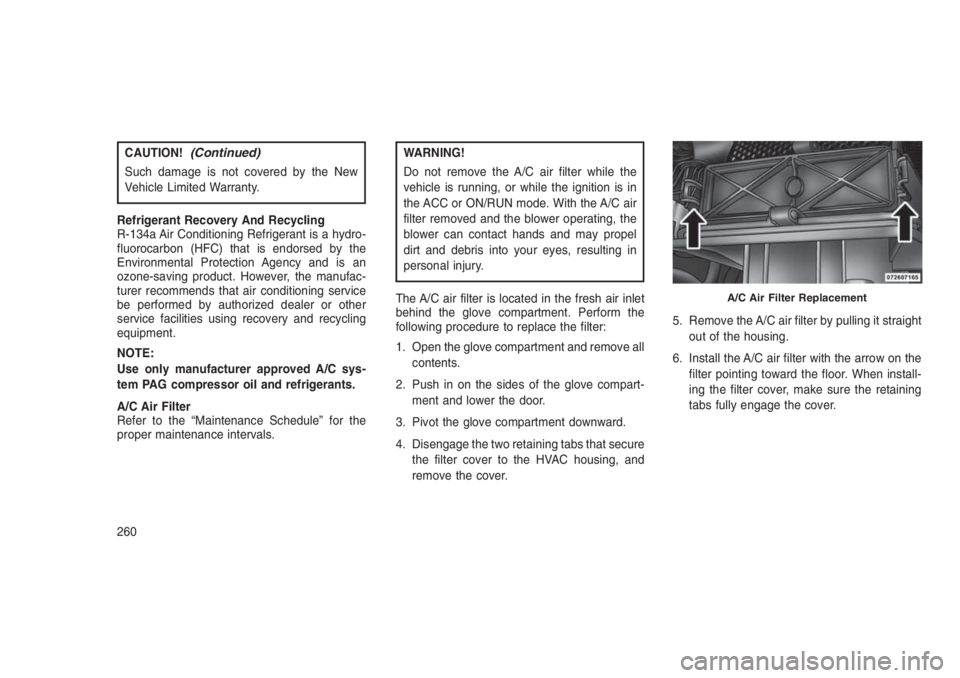
CAUTION!(Continued)
Such damage is not covered by the New
Vehicle Limited Warranty.
Refrigerant Recovery And Recycling
R-134a Air Conditioning Refrigerant is a hydro-
fluorocarbon (HFC) that is endorsed by the
Environmental Protection Agency and is an
ozone-saving product. However, the manufac-
turer recommends that air conditioning service
be performed by authorized dealer or other
service facilities using recovery and recycling
equipment.
NOTE:
Use only manufacturer approved A/C sys-
tem PAG compressor oil and refrigerants.
A/C Air Filter
Refer to the “Maintenance Schedule” for the
proper maintenance intervals.
WARNING!
Do not remove the A/C air filter while the
vehicle is running, or while the ignition is in
the ACC or ON/RUN mode. With the A/C air
filter removed and the blower operating, the
blower can contact hands and may propel
dirt and debris into your eyes, resulting in
personal injury.
The A/C air filter is located in the fresh air inlet
behind the glove compartment. Perform the
following procedure to replace the filter:
1. Open the glove compartment and remove all
contents.
2. Push in on the sides of the glove compart-
ment and lower the door.
3. Pivot the glove compartment downward.
4. Disengage the two retaining tabs that secure
the filter cover to the HVAC housing, and
remove the cover.5. Remove the A/C air filter by pulling it straight
out of the housing.
6. Install the A/C air filter with the arrow on the
filter pointing toward the floor. When install-
ing the filter cover, make sure the retaining
tabs fully engage the cover.
A/C Air Filter Replacement
260
Page 265 of 332
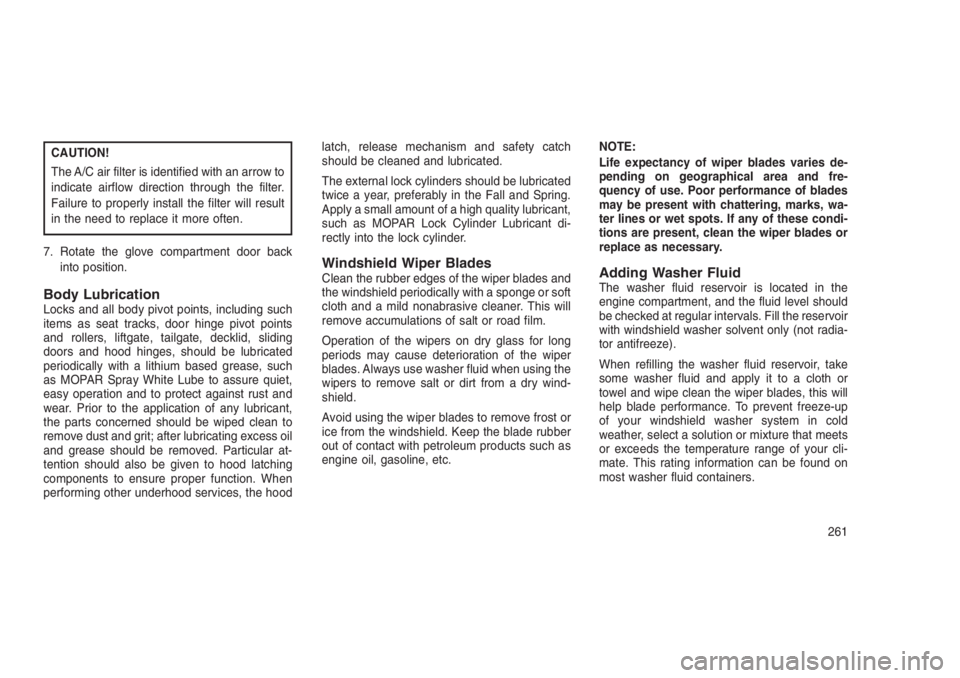
CAUTION!
The A/C air filter is identified with an arrow to
indicate airflow direction through the filter.
Failure to properly install the filter will result
in the need to replace it more often.
7. Rotate the glove compartment door back
into position.
Body LubricationLocks and all body pivot points, including such
items as seat tracks, door hinge pivot points
and rollers, liftgate, tailgate, decklid, sliding
doors and hood hinges, should be lubricated
periodically with a lithium based grease, such
as MOPAR Spray White Lube to assure quiet,
easy operation and to protect against rust and
wear. Prior to the application of any lubricant,
the parts concerned should be wiped clean to
remove dust and grit; after lubricating excess oil
and grease should be removed. Particular at-
tention should also be given to hood latching
components to ensure proper function. When
performing other underhood services, the hoodlatch, release mechanism and safety catch
should be cleaned and lubricated.
The external lock cylinders should be lubricated
twice a year, preferably in the Fall and Spring.
Apply a small amount of a high quality lubricant,
such as MOPAR Lock Cylinder Lubricant di-
rectly into the lock cylinder.
Windshield Wiper BladesClean the rubber edges of the wiper blades and
the windshield periodically with a sponge or soft
cloth and a mild nonabrasive cleaner. This will
remove accumulations of salt or road film.
Operation of the wipers on dry glass for long
periods may cause deterioration of the wiper
blades. Always use washer fluid when using the
wipers to remove salt or dirt from a dry wind-
shield.
Avoid using the wiper blades to remove frost or
ice from the windshield. Keep the blade rubber
out of contact with petroleum products such as
engine oil, gasoline, etc.NOTE:
Life expectancy of wiper blades varies de-
pending on geographical area and fre-
quency of use. Poor performance of blades
may be present with chattering, marks, wa-
ter lines or wet spots. If any of these condi-
tions are present, clean the wiper blades or
replace as necessary.Adding Washer FluidThe washer fluid reservoir is located in the
engine compartment, and the fluid level should
be checked at regular intervals. Fill the reservoir
with windshield washer solvent only (not radia-
tor antifreeze).
When refilling the washer fluid reservoir, take
some washer fluid and apply it to a cloth or
towel and wipe clean the wiper blades, this will
help blade performance. To prevent freeze-up
of your windshield washer system in cold
weather, select a solution or mixture that meets
or exceeds the temperature range of your cli-
mate. This rating information can be found on
most washer fluid containers.
261
Page 266 of 332
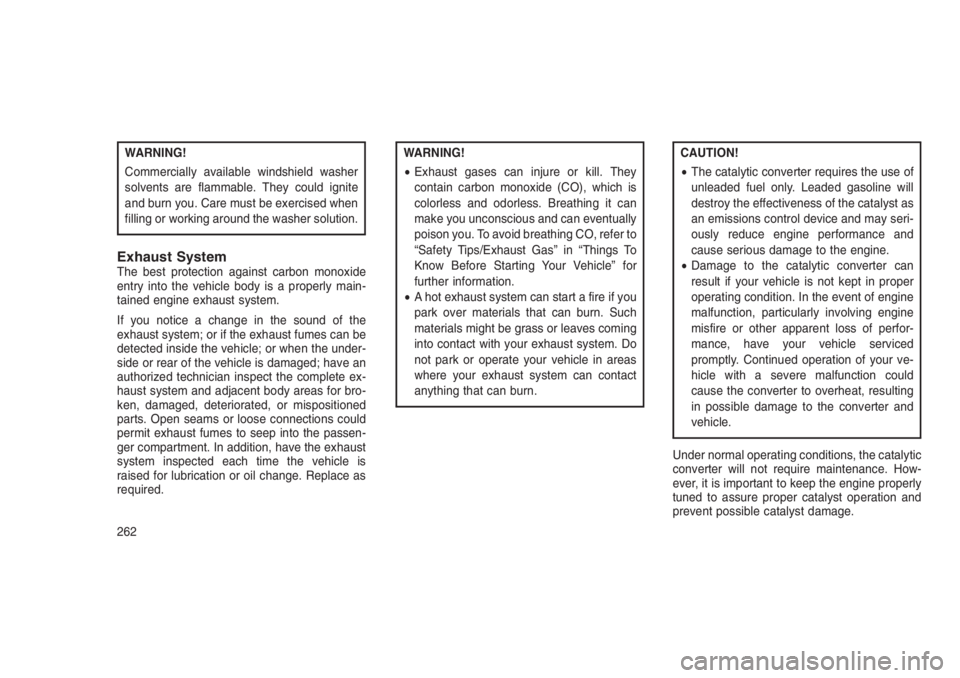
WARNING!
Commercially available windshield washer
solvents are flammable. They could ignite
and burn you. Care must be exercised when
filling or working around the washer solution.
Exhaust SystemThe best protection against carbon monoxide
entry into the vehicle body is a properly main-
tained engine exhaust system.
If you notice a change in the sound of the
exhaust system; or if the exhaust fumes can be
detected inside the vehicle; or when the under-
side or rear of the vehicle is damaged; have an
authorized technician inspect the complete ex-
haust system and adjacent body areas for bro-
ken, damaged, deteriorated, or mispositioned
parts. Open seams or loose connections could
permit exhaust fumes to seep into the passen-
ger compartment. In addition, have the exhaust
system inspected each time the vehicle is
raised for lubrication or oil change. Replace as
required.
WARNING!
•Exhaust gases can injure or kill. They
contain carbon monoxide (CO), which is
colorless and odorless. Breathing it can
make you unconscious and can eventually
poison you. To avoid breathing CO, refer to
“Safety Tips/Exhaust Gas” in “Things To
Know Before Starting Your Vehicle” for
further information.
•A hot exhaust system can start a fire if you
park over materials that can burn. Such
materials might be grass or leaves coming
into contact with your exhaust system. Do
not park or operate your vehicle in areas
where your exhaust system can contact
anything that can burn.CAUTION!
•The catalytic converter requires the use of
unleaded fuel only. Leaded gasoline will
destroy the effectiveness of the catalyst as
an emissions control device and may seri-
ously reduce engine performance and
cause serious damage to the engine.
•Damage to the catalytic converter can
result if your vehicle is not kept in proper
operating condition. In the event of engine
malfunction, particularly involving engine
misfire or other apparent loss of perfor-
mance, have your vehicle serviced
promptly. Continued operation of your ve-
hicle with a severe malfunction could
cause the converter to overheat, resulting
in possible damage to the converter and
vehicle.
Under normal operating conditions, the catalytic
converter will not require maintenance. How-
ever, it is important to keep the engine properly
tuned to assure proper catalyst operation and
prevent possible catalyst damage.
262
Page 267 of 332
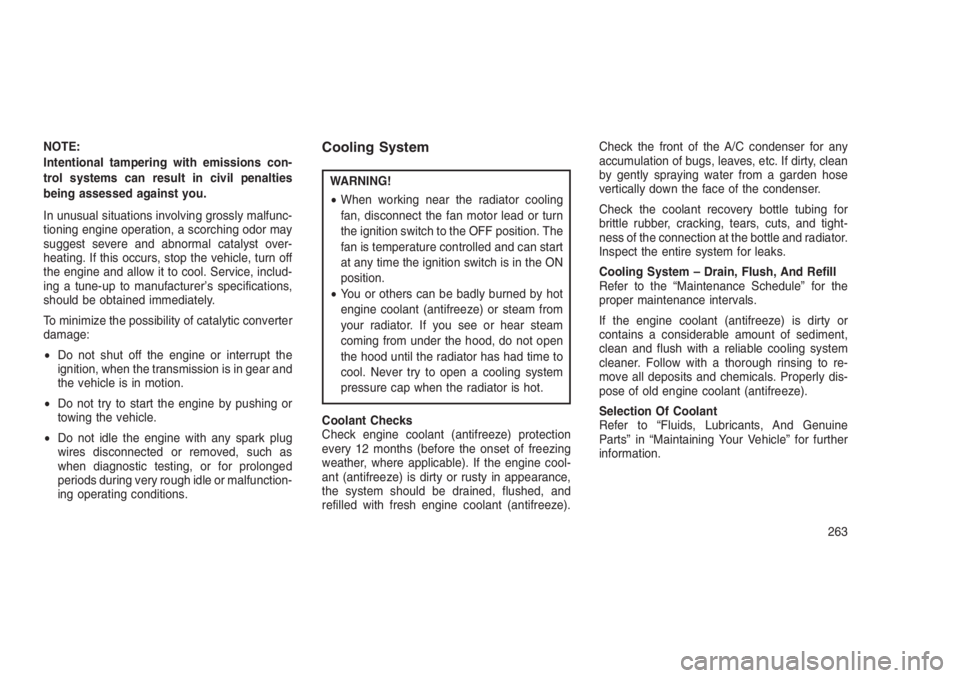
NOTE:
Intentional tampering with emissions con-
trol systems can result in civil penalties
being assessed against you.
In unusual situations involving grossly malfunc-
tioning engine operation, a scorching odor may
suggest severe and abnormal catalyst over-
heating. If this occurs, stop the vehicle, turn off
the engine and allow it to cool. Service, includ-
ing a tune-up to manufacturer’s specifications,
should be obtained immediately.
To minimize the possibility of catalytic converter
damage:
•Do not shut off the engine or interrupt the
ignition, when the transmission is in gear and
the vehicle is in motion.
•Do not try to start the engine by pushing or
towing the vehicle.
•Do not idle the engine with any spark plug
wires disconnected or removed, such as
when diagnostic testing, or for prolonged
periods during very rough idle or malfunction-
ing operating conditions.Cooling System
WARNING!
•When working near the radiator cooling
fan, disconnect the fan motor lead or turn
the ignition switch to the OFF position. The
fan is temperature controlled and can start
at any time the ignition switch is in the ON
position.
•You or others can be badly burned by hot
engine coolant (antifreeze) or steam from
your radiator. If you see or hear steam
coming from under the hood, do not open
the hood until the radiator has had time to
cool. Never try to open a cooling system
pressure cap when the radiator is hot.
Coolant Checks
Check engine coolant (antifreeze) protection
every 12 months (before the onset of freezing
weather, where applicable). If the engine cool-
ant (antifreeze) is dirty or rusty in appearance,
the system should be drained, flushed, and
refilled with fresh engine coolant (antifreeze).Check the front of the A/C condenser for any
accumulation of bugs, leaves, etc. If dirty, clean
by gently spraying water from a garden hose
vertically down the face of the condenser.
Check the coolant recovery bottle tubing for
brittle rubber, cracking, tears, cuts, and tight-
ness of the connection at the bottle and radiator.
Inspect the entire system for leaks.
Cooling System – Drain, Flush, And Refill
Refer to the “Maintenance Schedule” for the
proper maintenance intervals.
If the engine coolant (antifreeze) is dirty or
contains a considerable amount of sediment,
clean and flush with a reliable cooling system
cleaner. Follow with a thorough rinsing to re-
move all deposits and chemicals. Properly dis-
pose of old engine coolant (antifreeze).
Selection Of Coolant
Refer to “Fluids, Lubricants, And Genuine
Parts” in “Maintaining Your Vehicle” for further
information.
263
Page 268 of 332
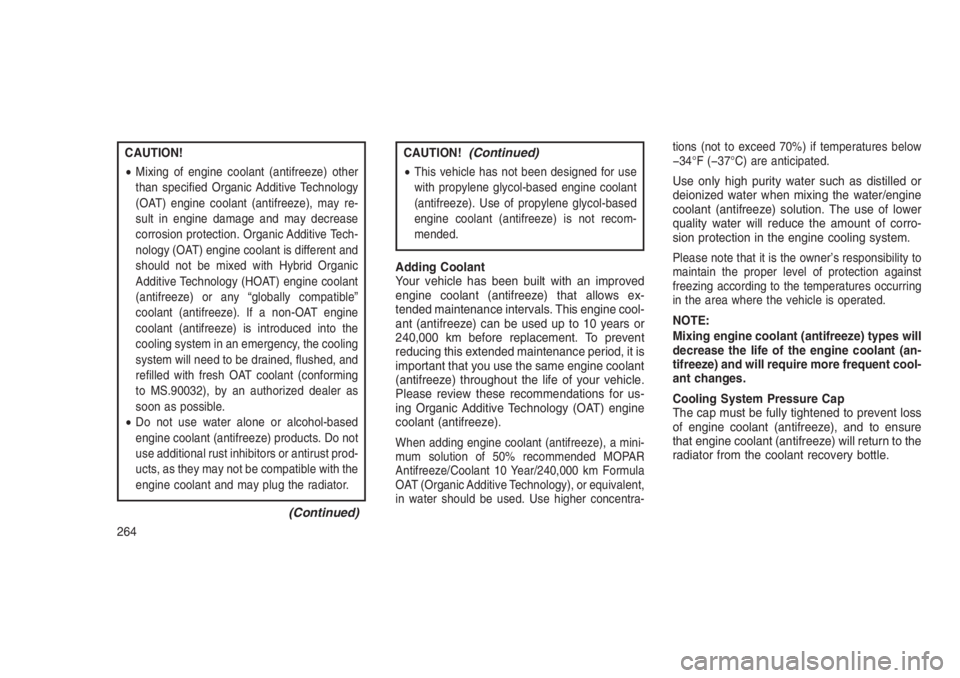
CAUTION!
•
Mixing of engine coolant (antifreeze) other
than specified Organic Additive Technology
(OAT) engine coolant (antifreeze), may re-
sult in engine damage and may decrease
corrosion protection. Organic Additive Tech-
nology (OAT) engine coolant is different and
should not be mixed with Hybrid Organic
Additive Technology (HOAT) engine coolant
(antifreeze) or any “globally compatible”
coolant (antifreeze). If a non-OAT engine
coolant (antifreeze) is introduced into the
cooling system in an emergency, the cooling
system will need to be drained, flushed, and
refilled with fresh OAT coolant (conforming
to MS.90032), by an authorized dealer as
soon as possible.
•Do not use water alone or alcohol-based
engine coolant (antifreeze) products. Do not
use additional rust inhibitors or antirust prod-
ucts, as they may not be compatible with the
engine coolant and may plug the radiator.
(Continued)
CAUTION!(Continued)
•This vehicle has not been designed for use
with propylene glycol-based engine coolant
(antifreeze). Use of propylene glycol-based
engine coolant (antifreeze) is not recom-
mended.
Adding Coolant
Your vehicle has been built with an improved
engine coolant (antifreeze) that allows ex-
tended maintenance intervals. This engine cool-
ant (antifreeze) can be used up to 10 years or
240,000 km before replacement. To prevent
reducing this extended maintenance period, it is
important that you use the same engine coolant
(antifreeze) throughout the life of your vehicle.
Please review these recommendations for us-
ing Organic Additive Technology (OAT) engine
coolant (antifreeze).
When adding engine coolant (antifreeze), a mini-
mum solution of 50% recommended MOPAR
Antifreeze/Coolant 10 Year/240,000 km Formula
OAT (Organic Additive Technology), or equivalent,
in water should be used. Use higher concentra-tions (not to exceed 70%) if temperatures below
−34°F (−37°C) are anticipated.
Use only high purity water such as distilled or
deionized water when mixing the water/engine
coolant (antifreeze) solution. The use of lower
quality water will reduce the amount of corro-
sion protection in the engine cooling system.
Please note that it is the owner’s responsibility to
maintain the proper level of protection against
freezing according to the temperatures occurring
in the area where the vehicle is operated.
NOTE:
Mixing engine coolant (antifreeze) types will
decrease the life of the engine coolant (an-
tifreeze) and will require more frequent cool-
ant changes.
Cooling System Pressure Cap
The cap must be fully tightened to prevent loss
of engine coolant (antifreeze), and to ensure
that engine coolant (antifreeze) will return to the
radiator from the coolant recovery bottle.
264
Page 269 of 332
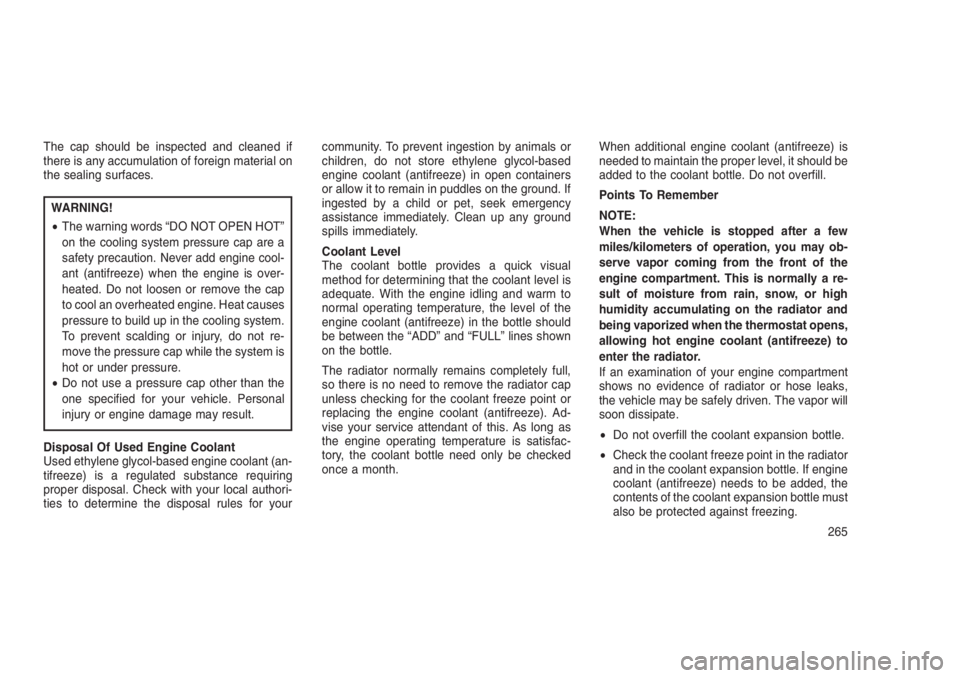
The cap should be inspected and cleaned if
there is any accumulation of foreign material on
the sealing surfaces.
WARNING!
•The warning words “DO NOT OPEN HOT”
on the cooling system pressure cap are a
safety precaution. Never add engine cool-
ant (antifreeze) when the engine is over-
heated. Do not loosen or remove the cap
to cool an overheated engine. Heat causes
pressure to build up in the cooling system.
To prevent scalding or injury, do not re-
move the pressure cap while the system is
hot or under pressure.
•Do not use a pressure cap other than the
one specified for your vehicle. Personal
injury or engine damage may result.
Disposal Of Used Engine Coolant
Used ethylene glycol-based engine coolant (an-
tifreeze) is a regulated substance requiring
proper disposal. Check with your local authori-
ties to determine the disposal rules for yourcommunity. To prevent ingestion by animals or
children, do not store ethylene glycol-based
engine coolant (antifreeze) in open containers
or allow it to remain in puddles on the ground. If
ingested by a child or pet, seek emergency
assistance immediately. Clean up any ground
spills immediately.
Coolant Level
The coolant bottle provides a quick visual
method for determining that the coolant level is
adequate. With the engine idling and warm to
normal operating temperature, the level of the
engine coolant (antifreeze) in the bottle should
be between the “ADD” and “FULL” lines shown
on the bottle.
The radiator normally remains completely full,
so there is no need to remove the radiator cap
unless checking for the coolant freeze point or
replacing the engine coolant (antifreeze). Ad-
vise your service attendant of this. As long as
the engine operating temperature is satisfac-
tory, the coolant bottle need only be checked
once a month.When additional engine coolant (antifreeze) is
needed to maintain the proper level, it should be
added to the coolant bottle. Do not overfill.
Points To Remember
NOTE:
When the vehicle is stopped after a few
miles/kilometers of operation, you may ob-
serve vapor coming from the front of the
engine compartment. This is normally a re-
sult of moisture from rain, snow, or high
humidity accumulating on the radiator and
being vaporized when the thermostat opens,
allowing hot engine coolant (antifreeze) to
enter the radiator.
If an examination of your engine compartment
shows no evidence of radiator or hose leaks,
the vehicle may be safely driven. The vapor will
soon dissipate.
•Do not overfill the coolant expansion bottle.
•Check the coolant freeze point in the radiator
and in the coolant expansion bottle. If engine
coolant (antifreeze) needs to be added, the
contents of the coolant expansion bottle must
also be protected against freezing.
265
Page 270 of 332
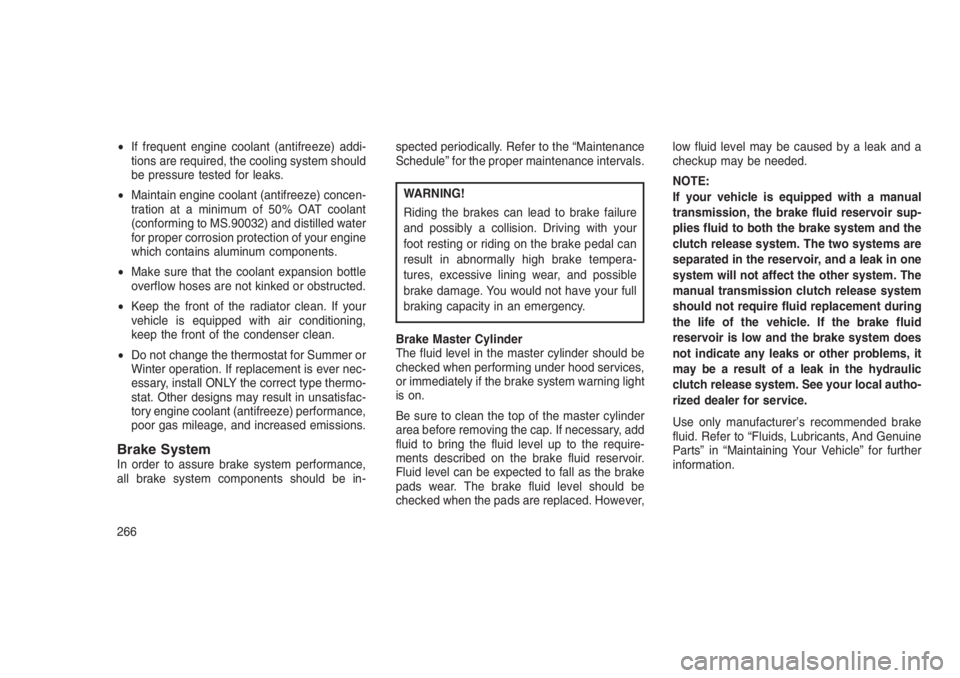
•If frequent engine coolant (antifreeze) addi-
tions are required, the cooling system should
be pressure tested for leaks.
•Maintain engine coolant (antifreeze) concen-
tration at a minimum of 50% OAT coolant
(conforming to MS.90032) and distilled water
for proper corrosion protection of your engine
which contains aluminum components.
•Make sure that the coolant expansion bottle
overflow hoses are not kinked or obstructed.
•Keep the front of the radiator clean. If your
vehicle is equipped with air conditioning,
keep the front of the condenser clean.
•Do not change the thermostat for Summer or
Winter operation. If replacement is ever nec-
essary, install ONLY the correct type thermo-
stat. Other designs may result in unsatisfac-
tory engine coolant (antifreeze) performance,
poor gas mileage, and increased emissions.
Brake SystemIn order to assure brake system performance,
all brake system components should be in-spected periodically. Refer to the “Maintenance
Schedule” for the proper maintenance intervals.
WARNING!
Riding the brakes can lead to brake failure
and possibly a collision. Driving with your
foot resting or riding on the brake pedal can
result in abnormally high brake tempera-
tures, excessive lining wear, and possible
brake damage. You would not have your full
braking capacity in an emergency.
Brake Master Cylinder
The fluid level in the master cylinder should be
checked when performing under hood services,
or immediately if the brake system warning light
is on.
Be sure to clean the top of the master cylinder
area before removing the cap. If necessary, add
fluid to bring the fluid level up to the require-
ments described on the brake fluid reservoir.
Fluid level can be expected to fall as the brake
pads wear. The brake fluid level should be
checked when the pads are replaced. However,low fluid level may be caused by a leak and a
checkup may be needed.
NOTE:
If your vehicle is equipped with a manual
transmission, the brake fluid reservoir sup-
plies fluid to both the brake system and the
clutch release system. The two systems are
separated in the reservoir, and a leak in one
system will not affect the other system. The
manual transmission clutch release system
should not require fluid replacement during
the life of the vehicle. If the brake fluid
reservoir is low and the brake system does
not indicate any leaks or other problems, it
may be a result of a leak in the hydraulic
clutch release system. See your local autho-
rized dealer for service.
Use only manufacturer’s recommended brake
fluid. Refer to “Fluids, Lubricants, And Genuine
Parts” in “Maintaining Your Vehicle” for further
information.
266